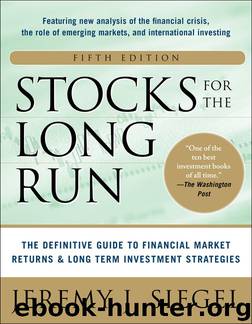Stocks for the Long Run 5E: The Definitive Guide to Financial Market Returns & Long-Term Investment Strategies by Jeremy J. Siegel

Author:Jeremy J. Siegel [Siegel, Jeremy J.]
Language: eng
Format: epub
Publisher: McGraw-Hill Education
Published: 2014-01-09T23:00:00+00:00
STOCKS AS HEDGES AGAINST INFLATION
Although the central bank has the power to moderate (but not eliminate) the business cycle, its policy has the greatest influence on inflation. As noted above, the inflation of the 1970s was due to the overexpansion of the money supply, which was an action the central bank took in the vain hope that it could offset the impact of the OPEC oil supply restrictions. This expansionary monetary policy brought inflation to double-digit levels in most industrialized economies, peaking at 13 percent per year in the United States and exceeding 24 percent in the United Kingdom.
In contrast to the returns of fixed-income assets, the historical evidence is overwhelming that the returns on stocks over long time periods have kept pace with inflation. Since stocks are claims on the earnings of real assets—assets whose value is intrinsically related to the price of the goods and services they produce—one should expect that their long-term returns will not be harmed by inflation. For example, the period since World War II has been the most inflationary period in our history, and yet the real returns on stocks have matched that of the previous 150 years. The ability of an asset such as stocks to maintain its purchasing power during periods of inflation makes equities an inflation hedge.
Indeed, stocks were widely praised in the 1950s as hedges against rising consumer prices. As noted in Chapter 11, many investors stayed with stocks at that time, despite seeing the dividend yield on equities fall below the interest rate on long-term bonds. In the 1970s, however, stocks were ravaged by inflation, and it became unfashionable to view equities as an effective hedge against inflation.
What does the evidence say about the effectiveness of stocks as an inflation hedge? The annual compound returns on stocks, bonds, and Treasury bills against inflation over 1-year and 30-year holding periods from 1871 to 2012 are shown in Figure 14-3.
Download
This site does not store any files on its server. We only index and link to content provided by other sites. Please contact the content providers to delete copyright contents if any and email us, we'll remove relevant links or contents immediately.
Hit Refresh by Satya Nadella(9038)
The Compound Effect by Darren Hardy(8808)
Change Your Questions, Change Your Life by Marilee Adams(7634)
Nudge - Improving Decisions about Health, Wealth, and Happiness by Thaler Sunstein(7615)
The Black Swan by Nassim Nicholas Taleb(7010)
Deep Work by Cal Newport(6877)
Daring Greatly by Brene Brown(6444)
Rich Dad Poor Dad by Robert T. Kiyosaki(6399)
Principles: Life and Work by Ray Dalio(6206)
Man-made Catastrophes and Risk Information Concealment by Dmitry Chernov & Didier Sornette(5921)
Playing to Win_ How Strategy Really Works by A.G. Lafley & Roger L. Martin(5914)
Digital Minimalism by Cal Newport;(5661)
Big Magic: Creative Living Beyond Fear by Elizabeth Gilbert(5610)
The Myth of the Strong Leader by Archie Brown(5424)
The Slight Edge by Jeff Olson(5346)
Discipline Equals Freedom by Jocko Willink(5283)
The Motivation Myth by Jeff Haden(5155)
Stone's Rules by Roger Stone(5026)
The Laws of Human Nature by Robert Greene(4996)
